R.E.M. - CD Singles Reviews
Back to artist page- 1991: Losing My Religion
- 1991: Shiny Happy People
- 1991: Near Wild Heaven
- 1992: Drive
- 1993: The Sidewinder Sleeps Tonite
- 1993: Everybody Hurts
- 1994: What's the Frequency, Kenneth?
- 1995: Bang and Blame
- 1996: E-Bow the Letter
- 1996: Electrolite
- 1998: Daysleeper
- 1998: Lotus
- 1999: At My Most Beautiful
- 1999: The Great Beyond
- 2001: Imitation of Life
- 2001: All the Way to Reno (You're Gonna Be a Star)
- 2004: Leaving New York

LOSING MY RELIGION
| Release year: | A-Side: | B-Sides: |
| 1991 | 10 | 5 |
1) Losing My Religion; 2) Rotary Ten; 3) After Hours (Live)
This is very likely going to be the first entry on this page for the foreseeable future (R.E.M. didn't do much in the way of CD singles before this point, for obvious technology reasons), so let me reiterate something that has been mentioned in passing during the main reviews page. Namely, that R.E.M. were never really a band who paid attention to b-sides. US artists never quite embraced the tradition in the way that e.g. European bands did and while some tried, for R.E.M. single bonus tracks were clearly things you tossed in the package to sate label requirements. Actual studio originals are incredibly rare - and often repurposed soundtrack cuts - and most of the time you either got some quaint covers, instrumental practice room jams or live songs. Lots and lots of live songs. In other words, if you ever were to dive into the world of collecting R.E.M. singles, temper your expectations. Accept and embrace the reality.
Case in point, the two b-sides here. "Rotary Eleven" is a bluesy instrumental that I imagine was a fun giggle in the studio when the band jammed it out after hours,but which doesn't translate into anything particularly rewarding to the home listener beyond demonstrating the range of the band's inspirations. Meanwhile, if there's ever been a side of you who passionately wants to hear R.E.M. cover The Velvet Underground live, you've got the live version of "After Hours" to quench your thirst. The rest of us can shrug and move along, perhaps occasionally having a polite chuckle at the unbelievably shoddiness of this performance where it feels like the band literally breaks down before the breakdown. The sound quality isn't great and it all has the air of a bad variety show performance.
What a complete contrast to the A-side, then. There are two kinds of immortal hit singles. Some are simply Damn Fantastic Songs. The others have a magical, spellbinding aura to them that pretty much guarantees that they were born to be legendary songs. "Losing My Religion" is one of the latter. As soon as you hear it for the first time, it's pretty clear why it was such a huge song. It never had any other choice. It's arresting in its delivery, the sort of song that takes control of the room it plays in instantly. It's mystical and mysterious and very dramatic, sounding out of this world and extremely important right from the get-go. It's the moment that R.E.M. turned from an excellent band into something truly remarkable, and it still sounds fresh and unlike anything else.
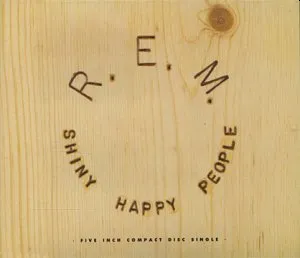
SHINY HAPPY PEOPLE
| Release year: | A-Side: | B-Sides: |
| 1991 | 9 | 6 |
1) Shiny Happy People; 2) Forty Second Song; 3) Losing My Religion (Live Acoustic Version)
Hello, I'm unfashionable and weird and I love this song!
It's stupidly upbeat, ridiculously fluffy and childishly bouncy, and oh my it does it excellently. I'm personally not interested about its possible darker lyrical connotations or subversive qualities or whatever else people theorise about it to make it less happy-go-lucky: I'm openly in love with how joyful and fun it sounds. The cavalcade of vocal harmonies during its choruses and near the end is especially fantastic, and the whole song just radiates warmth and good feeling. I can completely understand why the band regards it as a novelty song best buried under the annals of time, but I do have to say they make an excellent cutesy pop band when they get in the mood. Adorable, goofy and utterly lovable.
"Forty Second Song" is a short (although not forty seconds) studio jam instrumental, with a very Out of Time feel to it; you could imagine it as a rough sketch to song that probably could have been realised further during the sessions had they bothered, but they probably gave up because it does trace a lot of what had already been said on the album. The acoustic "Losing My Religion" is... an acoustic "Losing My Religion". It's a nice stripped-down rendition of a classic song, and one of many to be released in the decades to come - this doesn't have anything special to make it stand out from the others like it, but it's always a solid if retrospectively unsurprising listen.
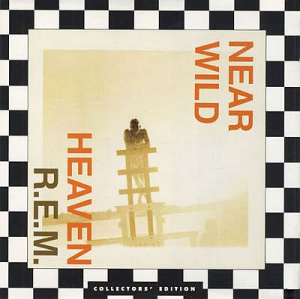
NEAR WILD HEAVEN
| Release year: | A-Side: | B-Sides: |
| 1991 | 9 | 7 |
1) Near Wild Heaven; 2) Tom's Diner (Live); 3) Low (Live); 4) Endgame (Live)
Mike Mills' backing vocals have always been one of R.E.M.'s greatest elements but he rarely got to be the lead outside a number of b-side cover songs. And yet, out of the three album lead vocals he ever got, two of them ended up being released as singles so clearly the band had faith in Mills standing in the spotlight.
"Near Wild Heaven" is Mills' greatest lead vocal moment. It's a genuinely, disarmingly lovely tune: the sweetest melody paired with the brightest jangle, an excellent chorus that lifts to flight effortlessly and an aura of summery free-spiritedness that makes it impossible to resist. It has the feel of a great number of golden classic vintage pop songs, played with the confidence of a band who had just started their imperial phase. Stipe takes over Mills' harmony role and the switch between his huskiness and Mills' softness works as effectively this way around as it does normally. In fact, it's Mills' lead vocals that really make the song so effortlessly lush - it's a gentle, bright song and Mills' cuddly pillow of a voice is the perfect match, whereas Stipe would've likely given it a wholly different tone.
The b-sides are a selection of live performances, and this time the cuts chosen seem to have been deliberately included to compliment the A-side: they're softer and a little light-hearted, and they have a feel of cosy comradery between the audience and the band. The Out of Time intermission instrumental "Endgame" is a good example: it isn't exactly a song that sets concerts alight but here it sounds so relaxed and casual it's hard not to smile with it, and when Stipe asks for people to join in on the harmonies it feels more like an on-the-whim, fun little engagement with fans than a serious stadium-like attempt at a singalong. "Low", originally a song with a darker, colder edge hidden in its relatively calm demeanour, gets a more acoustic sound here that warms it up, making it a little less brooding without straying too far away from the original: out of the b-sides it's probably the best quality-wise simply on the strength of the original. The main highlight however is the hilarious performance of Suzanne Vega's "Tom's Diner" - it starts out unassumingly but soon there's beatboxing, adlibs about currency exchange rates, sudden groovy drum beats (or attempts thereof) and Stipe audibly cracking up into giggles thanks to his bandmates (including Billy Bragg? Apparently he's featuring?) interjecting out of the blue with their own lines. It's the band with their guards down, caught during a moment of improvised fun and the good vibes radiate to the listener.

DRIVE
| Release year: | A-Side: | B-Sides: |
| 1992 | 9 | 8 |
1) Drive; 2) World Leader Pretend; 3) First We Take Manhattan
"Drive" is a curious song. It certainly doesn't sound like a single. It's moody and introspective and it stumbles more than it flows. Stipe mumbles over gently picked acoustic guitar while the rhythm section slowly crawls behind. But the song contains two extremely strong not-so-secret weapons. One is that each and every line that Stipe utters is incredibly incaptivating melodically and evocatively. It's a song made out of instantly engaging vocal melodies, whether it's the slowly burning verses or the more obvious, deliberately apathetic crowd singalong moments on the chorus. The second one is how it explodes. An electric guitar interrupts the chorus, lashes out, suddenly the quietly brooding strings from before turn gigantic. The song quiets down once again and while it gets louder again, it never gets quite as majestic as it did when it first happened. It doesn't need to either - that single second half of a chorus is already one of the best moments R.E.M. committed on tape.
The b-sides of this particular edition are the Green album track "World Leader Pretend" and the Leonard Cohen cover "First We Take Manhattan". The former one is a brilliant song but I can't help but feel that using an old album track as a b-side is a painfully cheap and pointless option to take. The latter is a rather good song that while a little overlong, makes up for its minor flaws with a particularly great-sounding organ, a tight rhythm section and the rather charming Mike Mills driven chorus. It stands out in the sea of covers released by this band as one that feels close to something a bit more integral, that there was a reason to record it beyond just filling up space on a disc. One of their best borrowed songs.

THE SIDEWINDER SLEEPS TONITE
| Release year: | A-Side: | B-Sides: |
| 1993 | 9 | 8 |
1) The Sidewinder Sleeps Tonite; 2) The Lion Sleeps Tonight; 3) Fretless
Lo and behold, it's a miracle - an R.E.M. b-side that is not only original studio material but also isn't an instrumental. In fact, R.E.M. were so excited about sharing their album outtakes for once that you can find "Fretless" across several different single releases, one of them being this one - originally it was released on the Until the End of Time movie soundtrack. Worth the spam, really - it's a really good song with a particularly wonderful, tension-driven atmosphere and another set of great backing vocals from The B-52s' Kate Pierson. Originally from the Out of Time sessions, it shares its musical DNA closer to that album's more intimate and homegrown sound than the lush orchestras of Automatic for the People so here it's perhaps a little askew tonally, but it is genuinely a R.E.M. curio worth hearing. from It's songs like "Fretless" that makes it all the more frustrating that R.E.M. never really shared their album outtakes - every glimpse we've gotten of the true discards is a thoroughly positive one.
"The Sidewinder Sleeps Tonite" itself is the token cheery song found on most melancholy, downbeat albums. And it is so very cheery, to the point that you can audibly hear Michael Stipe burst into a genuine little giggle during the third verse. Curiously, despite its hit status it's never become a particularly well-remembered single compared to the rest of the Automatic for the People singles squadron - and that's a shame, really. As far as upbeat R.E.M. goes, this is the gold standard everything else is measured to. Incredibly irresistable, genuinely joyous but never unbearably so, down to earth but surreally positive. It's the alternative rock version of the mythical Perfect Pop Song. A special mention goes out to the string section which is placed at the exact perfect location, hits in the best possible way and sounds so very lush.
The other b-side, besides the beforementioned "Fretless", is the band's take on the classic "The Lion Sleeps Tonight" - a nod to the origins of "The Sidewinder Sleeps Tonite" and its intro vocal melody, which was taken wholesale from "The Lion Sleeps Tonight". It's an affectionately accurate rendition of the stupidly charming original - a novelty song that I have a weird little affinity for - and the best thing about it is simply the fun of hearing R.E.M. acting so goofy and light-hearted. It appropriately to the original leans more on the novelty side of things, but as far as random covers go this does raise a smile on the face.
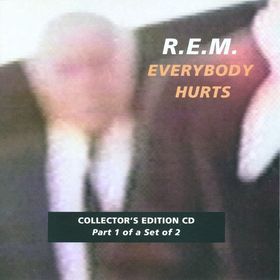
EVERYBODY HURTS
| Release year: | A-Side: | B-Sides: |
| 1993 | 8 | 7 |
1) Everybody Hurts (Radio Edit); 2) New Orleans Instrumental No. 1 (Long Version); 3) Mandolin Strum
"Everybody Hurts" is a song that could have easily gone wrong. It could very well have been melodramatic, cheesy, overblown or all above. Stipe chose to make the song as direct as possible to get the message through, and that too could have gone awry. It's testament to R.E.M.'s skills that "Everybody Hurts" turned out to avoid all those pitfalls. Stipe sells the simple lyrics by pouring his heart and soul into singing them and graces them with sincerity that lifts them up, and the arrangement of the music never becomes too tall and retains a sense of intimacy even when it starts to grow into its string-soaring epic size. It sounds like a genuine reach to support, rather than a forced stadium moment. That it became one of the iconic rock ballads of the 90s isn't really a surprise, but from its arrangement to its sentiment it feels out of place in that crowd. It's an intimate song that almost accidentally grows big over the course of its length, and that's why it still retains its magic.
The b-sides are two instrumentals, both titled very aptly. "Mandolin Strum" is an Out of Time-esque perky little number featuring Buck's go-to instrument of the time and maybe with a little extra work it could have turned into something more: as it is now, it's practically a demo with some make-up on. "New Orleans Instrumental No. 1" was a very lovely interlude on Automatic for the People and while it didn't need to go on for any longer, more of the same isn't bad. A little superfluous maybe, but all the little extra musical passages do is retain you in the song's soft embrace for a little while longer, and... well, that's not bad at all is it?
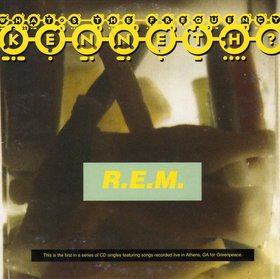
WHAT'S THE FREQUENCY, KENNETH?
| Release year: | A-Side: | B-Sides: |
| 1994 | 8 | 6 |
1) What's the Frequency, Kenneth? (Radio Version); 2) Monty Got a Raw Deal (Live); 3) Everybody Hurts (Live); 4) Man on the Moon (Live)
One of the definitive R.E.M. rock-out moments or at least one of the canonical classics of its kind. Stipe yelps over Buck's fuzzy guitar walls and Mills' solid groove, all building way to one of the band's most effortlessly singalongy choruses. Despite it being a fairly straightforward mid-tempo number it has an incredible amount of charm to it and packs a big, riff-tastic punch, and on top of it all its delivery is so upbeat it's infectious. It pumps you up. It's a song that takes a few basic building blocks and turns them into something instantly memorable and lovable in a particularly strong way.
The b-sides included are live cuts of three Automatic for the People songs. All three are fantastic songs but unlike in the release year of this single, by the present day we've heard so many live renditions of "Everybody Hurts" and "Man on the Moon" that it's hard to get excited over hearing yet another two of them. On the other hand, "Monty Got a Raw Deal" was rather rare live and its inclusion here is actually great in that regard. All three songs are played with the confidence of a great live band and they're overall really good versions so it's hard to fault them on a more "objective" basis, but from a personal point of view I rarely get excited over live songs as single b-sides and that's the case here as well. As great as the songs themselves are, the renditions here do not offer anything that would make them particularly different - or interesting - compared to their album versions.
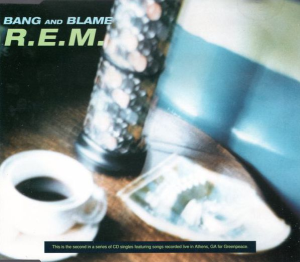
BANG AND BLAME
| Release year: | A-Side: | B-Sides: |
| 1995 | 9 | 7 |
1) Bang and Blame; 2) Losing My Religion (Live); 3) Country Feedback (Live); 4) Begin the Begin (Live)
In a discography as big as R.E.M.'s, some singles naturally slip through the cracks and do not get canonised in any way. "Bang and Blame" is one of those - you rarely hear anyone mention it, the band barely touched it past its mother tour and it's not one of those songs that bounce immediately out of Monster's tracklisting for most people. It's a disservice to a great song. Mills' bass leads the listener through the almost hypnotically swaying verses while Buck's guitar takes the center stage in the abrupt, minimalistic chorus - it's the standard loud-quiet-loud structure delivered in an excellent, R.E.M.-esque fashion. And as a details nerd, I have a huge soft spot for the oddball organ that pops up to bounce in the background right before the song is about to fade away.
The three live cuts that serve as the b-sides do a better-than-usual job. "Losing My Religion" sounds more raw and energetic than its studio counterpart, largely thanks to the amped-up acoustic guitar featured high in the mix - it demonstrates the different, electrified intensity of the Monster tour and stands out in an ocean of more acoustic, faithful live versions of the song in the band's back catalogue. "Country Feedback" is more laid back here rather than the intense bundle of drama it usually tends to be in a live setting and while the version of "Begin the Begin" offers no surprises in comparison to the original version, it's simply one of those songs that always had a great deal of presence and power in a live setting. A brief touch of amusing stage banter acts as a segue between the songs, which is a nice little thing in a single. Three good live versions of fantastic songs, can't really complain all that much (unless you just want to have a general moan over the abundance of live songs in R.E.M. singles which, fair).

E-BOW THE LETTER
| Release year: | A-Side: | B-Sides: |
| 1996 | 10 | 6 |
1) E-Bow the Letter; 2) Tricycle; 3) Departure (Rome Soundcheck Version); 4) Wall of Death
"E-Bow the Letter" is a wild choice for a single - let alone the lead single of the album and from an album that's otherwise so unlike it - but it's a statement piece. By the mid-90s R.E.M. had the clout to release anything they wanted as a single, even if it's a five and half minute (no radio edit!) drone-y and ethereal spoken word piece. But given the controversial rock and roll tones of Monster "E-Bow the Letter" was perhaps a peace offering, showing the band were back to the softer sounds of their early 1990s hits - even if still more electric. It's one of my all-time favourite songs - R.E.M. and otherwise - and it's arguably the source for a lot pet likes I've got, because this is where I got my love for the beautifully haunting sounds of an e-bowed guitar and the magic of a wonderfully executed spoken word piece for. Stipe isn't fronting this one as much as he is a conduit for the song, and together with the incredible arrangement and Patti Smith's feature is powerful and otherwordly. The whole song is otherwordly.
The b-sides are much more in tune with New Adventures in Hi-Fi, in that they're more laidback and loose and so unlike the A-side. The short surf rock instrumental "Tricycle" is another soundcheck fool-around jam and its iron wire guitar riff is hooky enough, but it's not going to get anyone wanting to hear it again anytime soon. The Rome soundcheck version of "Departure" is an alternative take on the New Adventures deep cut, and between its more limp energy and the idiculously fruity organ sound it's obvious why this wasn't the version the band went for. The Richard Thompson cover "Wall of Death" is the best of these b-sides, with R.E.M. briefly indulging in their Americana aspirations: there's some beautiful harmonies between Mills and Stipe, and some lush piano touches. It's not going to make anyone's favourite b-sides list, but it's got a little heart to it which sells it enough for it to finish the CD single gracefully.
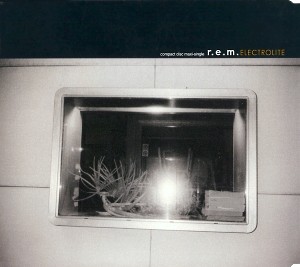
ELECTROLITE
| Release year: | A-Side: | B-Sides: |
| 1996 | 9 | 6 |
1) Electrolite; 2) The Wake-Up Bomb (Live); 3) Binky the Doormat (Live); 4) King of Comedy (808 State Remix)
The issue I have with R.E.M. releasing live versions of Monster / New Adventures in Hi-Fi songs from the ongoing tour as b-sides is that both albums were meant to be played live - the latter was even recorded live for most parts, with some studio clean up to remove audience noise etc. Therefore, live versions of these songs are just the album versions. This isn't even like it was with the version of "Departure" on the "E-Bow the Letter" single where the alternative recording actually featured a slightly different take on the song; both "Binky the Doormat" and "The Wake-Up Bomb" sound exactly as they're on the album. They're great songs, but seeing them on this tracklist feels like a con job. So the low rating for the b-sides isn't because of the songs themselves, it's their utter redundancy.
If you want something you can rate low, it's the 808 State remix of "King of Comedy". It's a textbook example of the most stereotypical remix you could think to find in a mid-90s alternative rock single. It is incredibly of its time and not in a way that would push it all the way back to nostalgic, and it's got none of the swagger, groove or charm of the original.
And thus, once again, if you were to combine the scores for the A-side and the bonus tracks together you'd once again really underrepresent how great the lead track is. "Electrolite" is a little cloud casually drifting along: a series of anecdotal, stream-of-consciousness verses gently tied together with a quaintly simple chorus, Buck's banjo and Mills' loungey piano. It doesn't show off, act big or dress to impress, and that's why it's such a charmer of a song. It's so incredibly free of the world's weight it's infectious, and it's so easy to fall in love with it and go on a jaunty little stroll together. It's also a case where I'd say the music video is essential viewing: its non-sequitur feel matches the song perfectly and the surreal visuals are inseparable from the song.
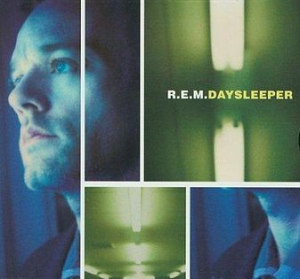
DAYSLEEPER
| Release year: | A-Side: | B-Sides: |
| 1998 | 10 | 8 |
1) Daysleeper; 2) Emphysema; 3) Why Not Smile (Oxford American Version)
Two perfect, brilliant songs surrounding an overlong novelty instrumental. "Daysleeper", the most traditionally R.E.M.-esque song off Up, is one of the highlights of an overall magnificent album and therefore makes its way by default among the band's very best songs - it's a beautiful, atmospheric classic watching the world with weary eyes and aching to rest with such tenderness to its breath. The Oxford American version of "Why Not Smile" strips away the electronic elements of the album version and in their place is simply a gently-picked acoustic guitar and a beautiful organ, bringing the song closer to a more vintage R.E.M. sound while heightening the intimacy of an already very touching song and providing it with additional warmth and comfort. It's such a great take that I actually can't decide whether I prefer this one to the original or not, as both versions have their own unique strengths. A must-have R.E.M. b-side - one of few.
And then there's "Emphysema", an instrumental practice space foolaround that sounds like it should accompany a secret agent scene in a cartoon; its hokey percussion and distinctive organ reminding me a great deal of the band's early 90s instrumental filler bonus tracks. It's more enjoyable than the average throwaway R.E.M. b-side instrumental but it really has no reason to go on for four and a half minutes when it's had its say in a little over a minute.
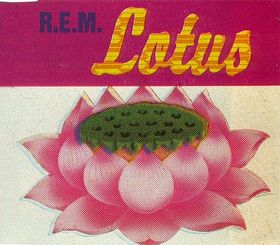
LOTUS
| Release year: | A-Side: | B-Sides: |
| 1998 | 10 | 7 |
1) Lotus; 2) Surfing the Ganges; 3) Lotus (Weird Mix)
If you are a fan of "Lotus", as I am, you owe yourself the small effort it takes to get hold of and listen to the Weird Mix found on this single. It's not a remix, a remake or anything like that: a careful eye might even catch this by looking at the track times and seeing how both the original version and the Weird Mix share the same running time. Rather, the Weird Mix is the exact same as the original "Lotus" - except, as the title says, it's mixed all weird. There's a lot of stereo isolation, a lot of dimmed sounds; at first it sounds like the work of a drunken mixer which the band found hilarious to the point of wanting to release it. The thing is though, the screwball mixing isn't random. The mix here pushes back the instruments that formerly dominated the song - the drums, the strings, the electric piano - and raises all the background elements to the forefront instead. "Lotus" is a remarkably dense song, full of countless little sounds from hidden melodies to seemingly random buzz sounds, together forming a thick jungle of sonic ideas that make the song so bewildering and immense. By tweaking the mix like the Weird Mix does, all those background details are now revealed. Did you know that there's bells in the track? No? There they are, perfectly audible in the Weird Mix. And suddenly, the denseness of "Lotus" begins to open up in ways that even its most hardcore listener had never realised before.
The other b-side "Surfing the Ganges" is an above-average R.E.M. instrumental, meaning that it's perfectly passable but nothing more than a curiosity. I do appreciate its whimsy and playfulness, even if it feels like Mills found a cheap vaguely sitar-sounding MIDI pattern in his keyboard and the whole Ganges thing was born out of that, but no one is going to reminisce about this song ever.
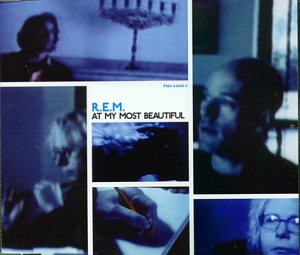
AT MY MOST BEAUTIFUL
| Release year: | A-Side: | B-Sides: |
| 1998 | 9 | 8 |
1) At My Most Beautiful (Radio Remix); 2) Passenger (Live); 3) Country Feedback (Live)
On Up the openly positive notes, optimistic lyrics and incredibly pretty melodies of "At My Most Beautiful" are a moment's break from the album's general melancholy, on its own it sounds like an uncharacteristically lovelorn ballad for R.E.M. I would say this is one of the band's most unusual singles even though it's such a soft and open song. But it is their loveliest single, with Mills backing vocals to die for. It's become one of my personal favourite love songs, as sappy and mushy as it is - but it's earnest about its affectations rather than trying to play an act, and the arrangement is a little marvel around Stipe's genuinely happy performance. The radio remix included here simply increases the volume in parts of the mix and production, and doesn't alter the song itself.
The b-sides for the issue I have are two live tracks taken from the Later With Jools Holland 1998 R.E.M. special (later included in the R.E.M. at the BBC box set). The audience-rousing Iggy Pop cover "Passenger" rocks out with a free spirit with all its la la la las and it's one of the more exciting covers the band have included as part of their b-sides - and it's a live track to boot, ticking off two categories in one go. "Country Feedback" is always amazing live, and sometimes I'd say it's one of the few songs that are always improved in a live setting because the band really lets the song's emotional ache out when performing it. And once again, it delivers. It's not the best live version I've heard of the song (that'll be the Perfect Square DVD performance), but it's still excellent.
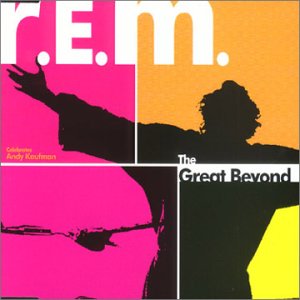
THE GREAT BEYOND
| Release year: | A-Side: | B-Sides: |
| 1999 | 10 | 7 |
1) The Great Beyond (Radio Edit); 2) Everybody Hurts (Live from Glastonbury); 3) The One I Love (Live from Glastonbury)
After Up's dense electro-melancholy, R.E.M. could have gone anywhere. Perhaps then that when Milos Forman asked R.E.M. to write a new theme song (and the incidental score) for the film he had titled after one of the band's earlier classics, he coincidentally pushed the band towards a new direction. "The Great Beyond" was in many ways a return to tradition: a full-band rock song with everyone going back to their traditional roles, grand in scope and stadium-ready, almost like nothing had ever happened in-between. But Up's influence is in the sonic precision of the production: it's busy and pristine, little bits and pieces moving around. The studio has become one of the instruments, but the sound still breathes. In many ways "The Great Beyond" would set the tone for the following Reveal, which effectively ran with the ideas presented here.
"The Great Beyond" has become something more than just a soundtrack cut: it's an iconic song in its own right, a classic for the band and one of their latter-day tracks that even the skeptics can agree with. It feels like a rebirth and sounds blissful about it, full of hope and wide-eyed wonder. It's a phenomenal song through and through, full of impactful segments that come together into a regal whole. The bridges where the song starts taking flight after the subdued verses, Stipe's rapid-fire delivery in the chorus, the starry-eyed optimism of its lyrics, the gorgeous grand finale, and all those lovely little details in its production. It is a brilliant piece of music and an R.E.M. essential.
The b-sides are like an emphasis of R.E.M.'s grand return that the A-side represents. The 1999 Glastonbury headline show is a milestone of its own, the band reclaiming their spot on top of the world after Up confused a good chunk of the general audience, blasting through a set of favourites with fired-up energy. Choosing two of the band's biggest hits from that gig for this single probably isn't too much of a coincidence. They're good renditions of great songs, and particularly "The One I Love" sounds huge - not the kind of live b-sides you'd place in a regular rotation because they don't really show anything new about the songs, but they're a good listen and the version of "The One I Love" has found a comfortable slot in my super-nerdy home-made digi-box set of b-sides and rarities (and later on the full concert was released on the R.E.M. at the BBC box set as well).
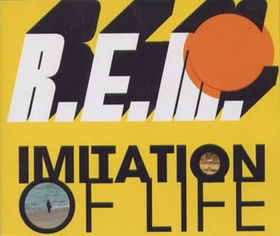
IMITATION OF LIFE
| Release year: | A-Side: | B-Sides: |
| 2001 | 9 | 9 |
1) Imitation of Life; 2) The Lifting (Original Version); 3) Beat a Drum (Dalkey Demo)
In a fun twist to the usual fare on how bands operate with b-sides, when you see an original song in the tracklist of a new R.E.M. single you can safely shrug and move on - it's just going to be another two-minute throwaway instrumental jam they pulled out in the studio while they were bored. But if you see any hint of a song being an alternative version of any sorts, a demo or an early version or anything like that, pay attention because that's where this band shines.
The two b-sides are a real treasure, both original versions of two Reveal songs. The original version of "The Lifting" bears practically no resemblance to the album version outside the lyrics and even those have been changed in places. There's no sign of the energetic, soaring opener that signals the band's return to a dynamic band sound on the album. Instead, the original "The Lifting" floats along in a meditational haze, driven by atmospheric guitar lines, tablas and strings. It rings out with a regal sound, gorgeously casting an atmospheric dream for five and a half minutes. It's so excellent that you wish the band had kept the music for another piece of lyric because it's too good to be thrown away completely when the final arrangement started to take form.
The demo of "Beat a Drum" is a far more conventional alternate take as it's got a fairly clear resemblance to the album version - the key difference here is that the song is stripped down to only voice, piano and acoustic guitar. It's sometimes said by people that the true strength of a song can be measured by taking it down to the bare bones and seeing if it still sounds good, and what was already one of Reveal's best moments reveal that yes indeed it works just as well with the bare minimum. It's a beautiful version of a wonderful song, still pastoral and awestruck but now closer and more intimate.
Fantastic A-side too. Almost as if to ensure people that the band has recovered from the depression that fueled the experimental Up, "Imitation of Life" was released as the lead single for Reveal and is as classic of a R.E.M. song as a song can be. Its sound is undeniably something that could only be R.E.M. and it comes off triumphantly. It's got a huge chorus for crowds to sing along to on the arena stages that band were ready to embrace again (even if ironically Reveal had no release tour), with a warm and lush sound to sink into, some classic Mills backing vocals and Buck jangles to cherish and Stipe being as excellent as he's ever been.
If you're a R.E.M. singles collector, keep this one at the top of your priorities list.
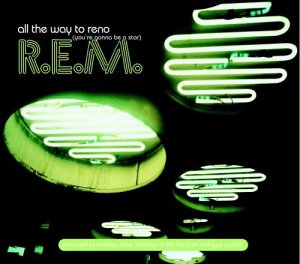
ALL THE WAY TO RENO (YOU'RE GONNA BE A STAR)
| Release year: | A-Side: | B-Sides: |
| 2001 | 9 | 7 |
1) All the Way to Reno (You're Gonna Be a Star); 2) Yellow River; 3) Imitation of Life (Live from Trafalgar Square)
Such a gorgeous song. Lazy summer afternoon weariness, 1960s psychedelia throwback in the arrangement, great vocals from both Stipe and Mills (whose backing vocals really make the chorus) full of those little vocal melody details that Stipe has always been so great at. It's always struck me just how relaxed it sounds, above all: it's a busy song if you break it into its components but as a whole it lulls around in its own space, gently floating above ground and going through its five minutes with no rush at all. It pulls the world into slow motion around it. More the chance to appreciate how lush it is, really. I've always considered this as one of the essential latter-day R.E.M. singles although in retrospect it's rarely talked in the same way as e.g. "Imitation of Life" or "Leaving New York" are - maybe my memories of this being constantly on repeat on music video channels and my own CD players throughout 2001-2002 is clouding my memory.
I've also always had an odd, almost nostalgic appreciation for the original "Yellow River" even though I have no recollection of ever listening to it all that much - some pop culture osmosis quirk I guess - so I have a ready-made affection towards R.E.M. covering it. It's wholly faithful to the original, and the main thing to pay attention to this from the R.E.M. side of things is that Mills gets the lead vocals. His gentle affectation works perfectly with the song and the overall recording is rather cute, in lack of a better word. The live version of "Imitation of Life" is pleasantly explosive, already showing itself off as the live anthem staple it was always destined to be. The song itself is of course great, but this live version doesn't do anything that would mean one should actively seek it out.
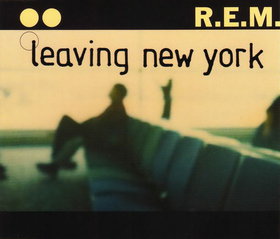
LEAVING NEW YORK
| Release year: | A-Side: | B-Sides: |
| 2004 | 9 | 6 |
1) Leaving New York; 2) You Are the Everything (Live); 3) These Days (Live)
Sadly after the b-side peak period of the past two albums, the Around the Sun singles bring back the usual live affairs. Both "You Are the Everything" and "These Days" being 1980s deep cuts foreshadow the band's impending personal archive binge, but I'm not a big fan of the recordings here. The performances are pretty faithful to the originals but they're almost too pristinely so, and because all the audience noise has been mixed out you might as well be listening to to slightly weaker studio versions. The lack of audience energy and interaction or any live feeling in general really brings both of these great songs down: especially the performance of "These Days" which is just so flaccid.
Regarding the actual lead track, Around the Sun tends to be viewed by most as somewhat of a letdown but even its most ardent naysayers have problems denying the greatness of "Leaving New York" - a damn near perfect track that's only slightly tarnished by Stipe's erratic grammar decision in the chorus. Gorgeous vocal harmonies layered over and over eachother, beautifully wistful mood and a grandiose chorus that brings the song into widescreen mode, peaking as the track moves to simply repeat those layered backing vocals over and over again, increasing the intensity of each unique line every go around. What a stunner.
Back to beginning
